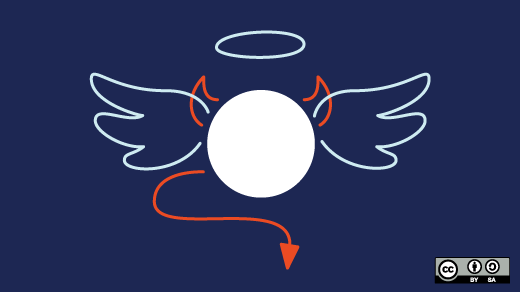The character of every member on your team impacts your open organization community's ability to be successful. But evaluating something like "character" is difficult. For starters, it's too broad to be measured and observed adequately. But as I explained in the first part of this series, character is connected to honesty, and honesty is connected to humility. We can track those a bit more easily using resources from the book The H Factor of Personality.
The book explains personality as a series of dimensions and traits. So let's now take a look at the other measurable characteristics of personality to get a better sense of how humility-honest (or "the H Factor") influences them—and, by extension, the behaviors we see in our open organizations. Along the way, I'll present what the authors of The H Factor of Personality recommend we do to spot Low-H actors in our organizations.
Six dimensions of personality
The authors present a six-trait model for understanding personality, called HEXACO:
- Honesty-Humility
- Emotionality
- eXtraversion
- Agreeableness (versus Anger)
- Conscientiousness
- Openness to Experience.
The authors mention that these summaries are reference points for wider personality traits. I explained the nuances of the first item, H-Factor, in my previous article. But honesty and humility never really operate in isolation; they're always intersecting with the other aspects of personality—with interesting results.
Emotionality (E)
"Persons with high scores on Emotionality overly fear physical danger, feel anxiety to life's stresses, need emotional support from others, and feel empathy with others," Lee and Ashton write. "Conversely, very low E scores are not deterred by danger, feel little worry in stressful situations, have little need to share concerns with others, and feel emotionally detached from others."
That means people demonstrating Low-H and Low-E behavior tend to embody "greed without fear," the authors say. They're risk-takers, and they hunger for money, fame, and power. They like to show off their risk-taking bravery, and they don't worry about others suffering. This person could do damage to one's team in an open organization.
On the other hand, write Lee and Ashton, persons exhibiting Low-H and High-E behavior tend to spend their efforts "weaseling and whining." That is, they exploit people using methods that are subtler, avoiding direct conflict (think of the student that exaggerates illnesses to delay submitting class assignments, say Lee and Ashton). This person could also be a burden to a team in an open organization.
eXtraversion (X)
Lee and Ashton write that "persons with very high scores on eXtraversion feel confident when addressing groups and experience positive feelings of enthusiasm. Conversely, persons with very low scores on this scale feel awkward when they are the center of attention, are indifferent to social activities, and feel less optimistic than others do."
Therefore, people demonstrating Low-H and High-X behavior are marked by what the authors call "narcissism run wild"; they consider themselves superior to others and think you should think of them as superior too. They also think of themselves as natural-born leaders and rulers. Their drive comes from a need for personal advantage only (not for others). An open organization could very productively include people with this personality as part of the community—but we must understand that their goals are typically not for the betterment of the community. They don't make for effective leaders.
On the other hand, people demonstrating Low-H and Low-X behavior are what Lee and Ashton call "the smug silent type." They might not desire status, but they do desire a reclusive life of great wealth and luxury, enjoyed in private, behind the walls of their great estate. People with this personality are difficult to imagine in open organizations, which are highly collaborative and inclusive by default.
Agreeableness (versus Anger) (A)
"Persons with very high scores in Agreeableness forgive others easily, are cooperative and can easily control their temper," Ashton and Lee explain. "Conversely, persons with very low scores hold grudges against others, are more critical, are stubborn in their point of view and anger readily."
For this reason, the authors call people who enact Low-H and Low-A behavior "just plain nasty." These people tend to exploit others, and to be chronically in conflict. While they are willing to offend and take offense easily, the authors say, they also fear being taken advantage of. This type of person could do great damage to your open organization's overall sense of motivation.
Lee and Ashton say that people demonstrating Low-H and High-A behavior are "not offensive but insincere." That is, these people are still greedy (they look after themselves first), but are very easygoing. They're easy to get alone with ("they have no permanent enemies, just permanent personal interests," Lee and Ashton write). With their own interests in mind, they can get along with even very unlikeable people. In our open organizations, we need to be sure people with this personality type understand how achieving community goals can help achieve personal goals too.
Conscientiousness (C)
Lee and Ashton says that "persons with very high scores on Conscientiousness are disciplined and organized, strive for accuracy and perfection, and deliberate carefully when making decisions." On the other hand, "persons with very low scores tend to be unconcerned with being orderly, avoid difficult challenges, ignore errors in their work, and make decisions on impulse with little reflection."
For the authors, someone that shows Low-H and Low-C behavior is "an employer's worst nightmare." They not only have a natural tendency toward sloppiness, but also no real work ethic. They could disrupt the team's work with little or no remorse. Given the authors' description, people with this personality type are the last people you'd want to recruit to your team in an open organization.
On the other hand, people demonstrating Low-H and High-C behavior are full of what Lee and Ashton call "selfish ambition." While people of this personality type are selfish, they control their impulses and plan for long-term personal goals (creating complex schemes for taking advantage of others). They tend to rely on technicalities in order to get their way. If these people have talent, they could rise to higher positions in business or politics. They could be helpful in an open organization community if they have needed skills and will benefit directly from their contribution. But they probably shouldn't be the community's leaders.
Openness to Experience (O)
Finally, Lee and Ashton write that "persons with very high scores in Openness to Experience enjoy the beauty of art and nature, seek knowledge, use imagination in everyday life, and take an interest in unusual ideas/people. Conversely, persons with very low scores are rather unimpressed by art, feel little intellectual curiosity, avoid creative pursuits, and feel nothing toward the unconventional."
In this case, people enacting Low-H and Low-O behavior are "shallow and narrow," Lee and Ashton say. That is, they're interested primarily in money and status. For them, something like science is worthwhile only for its ability to generate marketable products; nature is only valuable as a source of raw materials; art is only interesting as a source of investment or status. Material gain interests them most. Unless they see a way to gain something by participating in an open organization community, they wouldn't be interested in joining it.
On the other hand, people using Low-H and High-O behavior are characterized by "sophisticated snobbery," write the authors. You've probably encountered this type of person at some point in your life: They love to show off how cultured they are (and love using words that no one else understands). They're non-conformists who love attacking community moralities. I'd guess few open organizations would be comfortable with this type of person as a member.
Determining Personality Type
Determining a person's personality type can be complicated. As I've already said, this is a rather imprecise process. The best way to begin understanding your team's mix of personalities might be to use two types of questionnaires from The H Factor: a self-report and observer reports.
A self-report is a questionnaire given directly to the person being evaluated. It's something that must be done in a neutral setting, as the situation could skew the answers. Respondents shouldn't have incentive to answer one way rather than another. The questionnaire should contain some "neutral" questions to hide key questions, and, in general, its direct purpose should be hidden. Observer reports are questionnaires given to people who know the person being evaluated. This kind of report could be given to many people within a person's direct environment, like friends, parents, and colleagues.
But of the six personality categories I listed above, which are easiest to spot without a report?
According to the authors, eXtraversion is the easiest to spot (extroverted people tend to brag about their achievements more often). Emotionality and Openness to Experience are a little more difficult to spot. Agreeableness and Conscientiousness are even more difficult to determine.
H is the hardest of all to determine. Doing so requires observation over long periods of time and in a broad set of situations. The authors also recommend analyzing a person's peer group; High-H people tend to attract other High-H people and stay away from Low-H people.
Character is important for the success of any open organization community, and each community member's desire to contribute will determine how well the community achieves its purpose. The H Factor provides a useful set of tools for beginning to think about personality types that constitute a community and analyze potential strategies for maximizing contributions from all members—strengthening our open organizations and making them more productive.







Comments are closed.